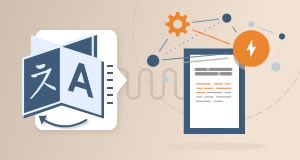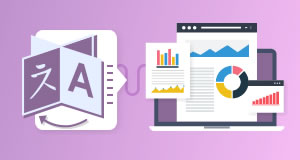Hands up if you’ve ever used Google Translate? Well, me too! I’m guessing we’ve all used it at some point whilst surfing the net, but for what purpose? For me, it’s mainly when shopping on Japanese or Korean e-commerce sites, or reading blogs and articles from overseas for work. The reason I click on that little pop-up when it appears in the right-hand corner of my screen? To get the gist of what it is I’m quickly skimming over. For online shopping sites, it’s usually to double check that the store ships to the UK and that the delivery charges aren’t extortionate. Unfortunately, more and more businesses are relying on Google’s open-source translation solution, or other machine translation systems, to translate the international versions of their website, which can be a dangerous decision to make!
What is machine translation?
Machine translation (MT) refers to computer-generated translations which draw on large databases of pre-translated content and attempt to recreate the source text in the required language. MT can either be rule-based or statistic-based.
 Modern systems are “trained” by MT engineers who constantly feed glossaries and documents into the system in order to both increase the reference material stored in the database, and attempt to provide more contextual examples of when a particular phrase can appear. Then, when it comes down to it, the system is supposed to be able to make an educated guess as to which translation is the most appropriate fit – notice how I say “appropriate” and not “accurate”!
Modern systems are “trained” by MT engineers who constantly feed glossaries and documents into the system in order to both increase the reference material stored in the database, and attempt to provide more contextual examples of when a particular phrase can appear. Then, when it comes down to it, the system is supposed to be able to make an educated guess as to which translation is the most appropriate fit – notice how I say “appropriate” and not “accurate”!
Don’t get me wrong, MT has definitely come a long way since its inception during the 1950s; however, there are still a lot of pitfalls to using this method of translation for business use.
Literal translation, not localisation
No matter how well you “train” a machine translation system, there’s always going to be an issue in that it is still a machine. Unless artificial intelligence progresses at lightning speed in the next decade, it’s unlikely that machine translation software will ever be able to understand, appreciate and use local nuances, peculiarities and idiosyncrasies present in all of the world’s languages. And when it comes to humour, sarcasm and satire? Well, that’s another kettle of fish altogether!
It is often quite clear when written content has been machine translated due to the stilted, fractured syntax produced by such systems. Google Translate, for example, uses similar technology as their search engine by chopping sentences into segments which are then searched for automatically on the web and then used to piece together sentences in the required language. In addition to this algorithm, the system does not understand grammatical rules at all. In fact, it pretends that it does due to the segmentation rules it applies, often placing commas in weird and wonderful places within the text.
Let’s have a look at some examples generated by the web-based MT system from English into Simplified Chinese, European Spanish and Italian:
Simplified Chinese
In example one, the word “take” is translated literally as “(to) take out (an item)”, which is a correct translation but in this particular context it is inaccurately used. For example two, “(I) will have” is literally translated as “will possess/own”, as in “I will possess/own the chicken salad”. The noun “dressing” is translated as “medical dressing” rather than “sauce/condiment” as intended in the English. For the final example, there is a syntactic error in that the Chinese word for “ticket” appears before “festival” so that the overall meaning of the sentence changes to read as if the “weekend festival” is owned by the “ticket”, rather than the “ticket” belonging to the “music festival”. The possession has changed as a result of the incorrect order of syntax.
European Spanish
Although the first example reads with pretty much the same meaning in Spanish, example two has some errors present. Again, “(I’ll) have” was translated using the possessive “tener” as opposed to the correct form “tomar”, meaning “to have” in the sense of eating the salad when it is brought to the table. “Dressing” is also confused in Spanish as the system populates the sentence with the term for “dressing room”. The same arises in the third example which again switches the possession between the “ticket” and the “music festival”.
Italian
Interestingly across the three examples in Italian the meaning is accurate, the syntax is also correct, but the style is a little skewed. Of course, style is subjective so perhaps some Italian speakers would be happy with this translation.
Depending on how a particular system is “trained”, some languages may have had more source material fed into it, meaning there is a lot more reference material to work with. The examples above show that this could quite possibly be the case for the Italian phrases as they appear to be the most accurate of the three.
Machine translation for business use
When it comes to translating content as part of your international marketing strategy, MT is definitely not the way to go. Yes it’s cheap and there’s minimal effort required on you part, but at the end of the day do you really want to lower the value of the high quality content you’ve created for your home market? Whether you’re looking to translate a marketing brochure, technical user manual or corporate website, all the time and money spent producing these materials will be in vain as MT will not do your content justice.
For businesses in more technical industries such as manufacturers, engineers, and chemical companies, there is a vast amount of terminology which is incredibly specific and must be carefully and accurately translated into the target language. Depending on the intended output of the translated content, then things like health and safety instructions must be accurately translated and you cannot risk getting the meaning wrong by passing the text through a MT system.
The benefit of using human translators is that they have a firm grasp on the way that specific terminology should be translated as well as an excellent command of their native language. Syntactic, grammatical and stylistic errors will be minimal when using humans to translate your business content, and if issues do arise then they’ll certainly be picked up, and corrected, in the proofreading, review stage.
What’s more, if you’re looking to implement an international SEO strategy to your site, but you’ve used MT to translate the page content, then this will almost certainly affect the way you carry out a page content review.
A word of warning
The final point I need to make is that when you decide to go for human translators, you should still be a little wary. Time and time again I get asked to take a look at companies’ websites to evaluate the quality of the existing multilingual content, and time and time again I have had to be the bearer of bad news when we discover that what the client thinks is human translation is actually the result of a machine translation system.
For advice on how to ensure that your translations are of an extremely high quality, please refer to my past post about reviewing your translations.
Emily MacKenzie
Latest posts by Emily MacKenzie (see all)
- What is SEO-localisation? - May 11, 2018
- Agile processes for continuous delivery: A focus on SEO-localisation - May 11, 2018
- E-book review: Undertaking SEO-localisation in a world of continuous delivery - May 11, 2018












[…] computer software to support them during the translation workflow; this is not to be confused with machine translation. There are various software packages on the market, with the most popular including, but not […]
[…] Machine translation is a useful tool on a casual level but it's to be avoided when translating your professional website – find out why! […]
Especially companies that create marketing texts to reach out to their clients risk to lose reputation and credibility when using Machine Translation. Whatever impact the company’s content creators and copywriters hoped to produce on their audience, it is destroyed as soon as Machine Translation systems start to piece together segments found in those “large databases of pre-translated content“. MT systems don’t only recycle “used” human translations, but – the more machine-translated content floods the Internet – get “trained” on their own output. If a company is serious about building trust when going global, the worst decision it can take is to use Machine Translation.
[…] Machine translation is a useful tool on a casual level but it's to be avoided when translating your professional website – find out why! […]
For a different viewpoint that suggests why MT might be useful for many of us including some in the professional translation industry see these opinions.
http://kv-emptypages.blogspot.com/2010/01/why-machine-translation-matters.html
http://kv-emptypages.blogspot.com/2010/03/why-machine-translation-matters-part-ii.html
http://kv-emptypages.blogspot.com/2010/01/why-machine-translation-matters-for.html